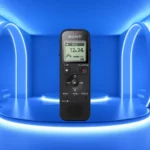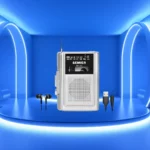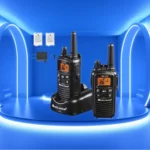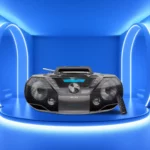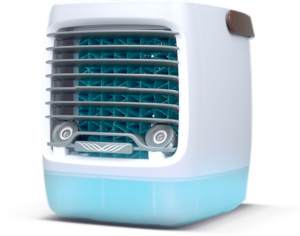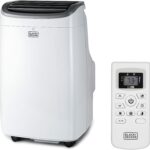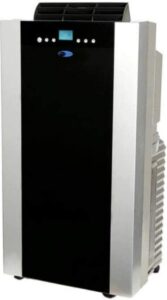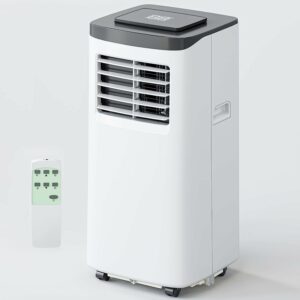Top 5 Best Portable Air Conditioners
✓ Updated: July 28th 2023
Imagine yourself in the middle of the sweltering summer heat, craving for an oasis of coolness. Now, imagine carrying that oasis with you, wherever you go. We all want a portable air conditioner to be that for us.
Well after thorough testing and analysis of the top 5 Portable Air Conditioners of 2023, it's clear that these 5 stand out from the rest. Check out the list below ↓↓↓
- #1 Most Effective Portable Air Conditioner Alternative
- Big Savings: Stop running up your cooling bill every summer! ChillWell 2.0 is much more energy efficient than a typical air conditioner with a shockingly low electricity bill that won’t make you sweat!
- Insta-Frost Technology: With their revolutionary Frost Jets you get an instant blast of polar air.
- Customizable Cooling: ChillWell 2.0 has 3 speeds, high medium and low, + TURBO mode for the ultimate blast of cooling. You can even add ice cubes to the cooler tank!
- Rapid Cooling Action: Unlike traditional AC systems that slowly try to cool down an entire room or house, ChillWell 2.0 focuses on just one area at a time.
- Easy to Use: No complicated set-up needed! Simply charge ChillWell 2.0 using the included USB charging cable, turn it on, and relax.
- Sleek Design: Completely portable and rechargeable to take anywhere with you!
- 60-Day Money Back Guarantee: Enjoy a risk-free trial with a hassle-free return policy if you're not 100% satisfied.
- Sold out throughout the year due to popularity
“AMAZING”
9.8

"The Best Portable Air Chiller"
2400 Reviews
Up to 57% off Discount
- Black+Decker 8,000 BTU Portable Air Conditioner
- Portable AC: This personal BLACK+DECKER AC (15.3"x14"x24.8") cools rooms up to 350 sq. ft., perfect for hot summers and peaceful sleep.
- 3-in-1: This 4100 BTU DOE (8000 BTU ASHRAE 128) AC also serves as a dehumidifier & fan. With a remote and top LED control panel.
- Features: The AC has adjustable temperature, a washable filter, auto-evaporation, and 24-hour timer.
- Mobility: With casters and side handles, this compact AC can be effortlessly moved around.
- Installation: The AC comes with an easy-to-install window kit, and its large, vented outlet ensures cool airflow.
- Sized to fit do the job most efficiently: Comes in 6 different sizes: 8,000 BTU - 10,000 BTU - 12,000 BTU+Heat - 12,000 BTU - 14,000 BTU+Heat - 14,000 BTU.
- Requires an exhaust hose and a window
- Very expensive at around ~$300
“EXCEPTIONAL”
9.6

"Works like a charm"
42,532 Reviews
- SereneLife SLPAC8 SLPAC 3-in-1 Portable Air Conditioner
- Compact & Mobile: SereneLife's Portable AC is a light, sleek unit designed for bedrooms, living rooms or garages, with wheels for easy movement.
- Versatile Modes: This compact AC unit plugs in easily, offering cooling, dehumidifier and fan modes, plus an automatic swing mode for optimal air circulation.
- Integrated Dehumidifier: Besides cooling, the unit reduces humidity, offering substantial cost and space benefits.
- Remote-Controlled: The AC features a digital control panel for power, mode, timer, temperature and fan speed adjustments.
- Cooling Power: Comes in 6 different sizes: 8,000 BTU - 10,000 BTU - 10,000 BTU+Heat - 12,000 BTU - 12,000 BTU+Heat - 14,000 BTU.
- Requires an exhaust hose and a window
- Very expensive at around ~$320
“EXCELLENT”
9.5

"Very effective unit"
23,618 Reviews
- Whynter ARC-14S 14,000 BTU Dual Hose Portable Air Conditioner
- Eco-friendly AC: Our portable AC lowers energy use while cooling your room.
- Versatile: The portable AC also acts as a dehumidifier and fan for spaces up to 500 sq ft.
- Moisture Recycling: Our dual-hose AC uses collected moisture to cool air and can dehumidify up to 71 pints/day.
- Robust & Quiet: The 14,000 BTU AC, under 56 dBA noise, uses eco-friendly R-32 refrigerant and lead-free components.
- Included: The AC package comes with a cover, window kit, remote, two filters, user manual, and 60-inch exhaust hose.
- Included: The AC package comes with a cover, window kit, remote, two filters, user manual, and DOUBLE 60-inch exhaust hose.
- Requires an 2 exhaust hose and a window
- Very expensive at around ~$375
“GREAT”
9.3

"Great if you can afford it"
9,619 Reviews
- ZAFRO 8,000 BTU Portable Air Conditioners
- Energy-efficient Cooling: ZAFRO's 8,000 BTU portable air conditioner provides rapid and efficient cooling for rooms up to 350 Sq.Ft, also reducing your electricity bill.
- 3-in-1 Functionality: Offers Cool/Dry/Fan modes with a user-friendly digital display and remote control.
- Quiet Operation: Features their 2023 generation compressor with sleep mode for minimal noise interference at night.
- Washable Air Filter: Comes with a removable, double-layer filter improving air quality.
- Easy Installation & Portability: Comes with wheels, hose & window adapter for easy installation and portability across rooms.
- Requires an exhaust hose and a window
- Very expensive at around ~$290
“VERY GOOD”
9.1

"Not energy efficient"
1,640 Reviews
- FIOGOHUMI 10000BTU Portable Air Conditioner
- Cooling: Efficient rotary compressor delivers exceptional cooling in just 6 minutes with a capacity of 10,000 BTU.
- Multifunctional: AC units offer cooling, dehumidifying, and fan functions.
- Quiet Operation: Units ensure a low noise level for peaceful surroundings. Intelligent sleep mode conserves energy.
- User-Friendly Design: All-in-one LED display and 24-hour timer allow easy operation. Units are portable with 360° wheels and ergonomic handles, blending into any decor.
- Excellent Support: All units come with a 2-year warranty and lifetime technical support for absolute customer satisfaction.
- Requires an exhaust hose and a window
- Very expensive at around ~$350
“GOOD”
8.7

"Nice but needs more power"
289 Reviews
- #1 Most Effective Portable Air Conditioner Alternative
- Big Savings: Stop running up your cooling bill every summer! ChillWell 2.0 is much more energy efficient than a typical air conditioner with a shockingly low electricity bill that won’t make you sweat!
- Insta-Frost Technology: With their revolutionary Frost Jets you get an instant blast of polar air.
- Customizable Cooling: ChillWell 2.0 has 3 speeds, high medium and low, + TURBO mode for the ultimate blast of cooling. You can even add ice cubes to the cooler tank!
- Rapid Cooling Action: Unlike traditional AC systems that slowly try to cool down an entire room or house, ChillWell 2.0 focuses on just one area at a time.
- Easy to Use: No complicated set-up needed! Simply charge ChillWell 2.0 using the included USB charging cable, turn it on, and relax.
- Sleek Design: Completely portable and rechargeable to take anywhere with you!
- 60-Day Money Back Guarantee: Enjoy a risk-free trial with a hassle-free return policy if you're not 100% satisfied.
- Sold out throughout the year due to popularity
“AMAZING”
9.8

"The Best Portable Air Chiller"
2400 Reviews
Up to 57% off Discount
The Ultimate Guide to Portable Air Conditioners
Looking for more information on portable air conditioners? We got you! especially if you've been considering alternatives to conventional central air conditioning or window units. In essence, a portable air conditioner (PAC) is a compact and movable cooling device that can bring comfort to various spaces, from small apartments to larger offices. Yet, what distinguishes it from other air conditioners, and more importantly, how does they even work?
What is a Portable Air Conditioner?
A portable air conditioner is an air conditioning unit designed to cool a single room or a specific area. As the name suggests, its portability is one of its main selling points. Unlike traditional central air conditioners or window units, you can move portable air conditioners from room to room, cooling only the area you're using, thus saving energy.
The unit comprises components like a compressor, a condenser, an expansion valve, and an evaporator, much like any air conditioner. What sets it apart is that all these components are housed within a single casing, a design that enhances its mobility. Usually these units with 1 or 2 intake/exhaust hoses.
We should note that they are only kind of portable. They do require a real power source and a window to attach the hoses to.
If you are looking for something 100% portable, rechargeable that can come with you anywhere like a Car, Motorhome, or any room without windows and more > Check This One Out <
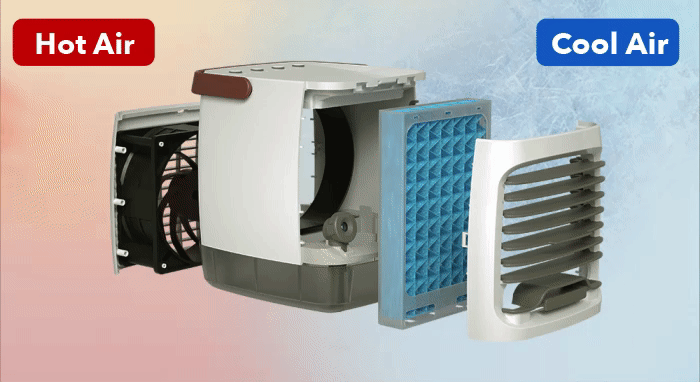
How Does a Portable Air Conditioner Work?
Portable air conditioners use the principles of refrigeration to cool a room. Warm room air is drawn into the unit, where it passes over the cooling evaporator coils. The refrigerant within these coils absorbs the heat from the air, resulting in a cooling effect. This cooled air is then recirculated back into the room, lowering the overall temperature.
During this process, moisture is also extracted from the air, reducing the humidity and contributing to a more comfortable environment. The hot air and moisture are typically vented out through a window using an exhaust hose.
What are the Key Features of a Portable Air Conditioner?
Portable air conditioners come with a variety of features. Firstly, they offer different cooling capacities, measured in British Thermal Units (BTUs). Larger rooms require units with more BTUs, while smaller spaces can make do with less.
As a general rule, an air conditioner needs 20 Btu for each square foot of living space you wish to cool and if you have higher ceilings then I would double that to 40 BTU per sqft
Lastly, as they're designed for mobility, most Portable air conditioners come with casters or handles for easy transportation and moving around.
What Factors Should Be Considered When Choosing a Portable Air Conditioner?
Before purchasing a portable air conditioner, consider the following factors:
- Room Size: The unit's BTU rating should correspond to the room size for efficient cooling.
- Noise Level: Like all machines, Portable air conditioners produce noise. Some models are quieter than others, so consider this if noise might be a concern.
- Energy Efficiency: Look for units with high Energy Efficiency Ratio (EER) ratings. The higher the EER, the more energy-efficient the unit is.
- Maintenance: Portable air conditioners require regular maintenance, such as cleaning or replacing filters. Consider this when choosing a unit.
Cost: Prices for portable air conditioners vary widely based on their features and BTU rating.
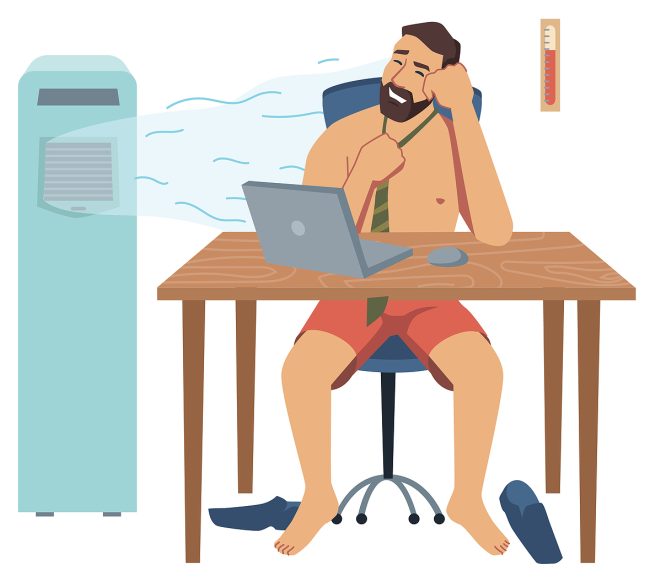
Can a Portable Air Conditioner Replace a Central Air Conditioner?
While portable air conditioners provide convenient and efficient cooling for specific areas, they aren't designed to replace central air conditioning systems, which are more suited to cooling larger homes uniformly. Portable air conditioners are excellent for supplementing central AC, for spot cooling, or for use in homes without an existing cooling system.
To sum up, portable air conditioners are a versatile, energy-efficient solution for cooling single rooms or small apartments. Their ease of installation, portability, and diverse features make them a popular choice. By understanding how they work and what to consider when buying one, you can make an informed decision and choose the best unit for your needs.
Types of Portable Air Conditioners
Single-hose units: These extract hot air from the room and expel it outside. However, they can struggle in larger spaces as they create negative pressure, which can lead to warm air being drawn back into the room.
Dual-hose units: These models have two hoses: one to draw in air from the outside to cool the condenser and another to exhaust the warm air back outside. They are more efficient at cooling larger spaces as they don't create negative pressure.
How to Install a Portable Air Conditioner
Installing a portable air conditioner is typically a straightforward process. Most come with a window installation kit that includes an exhaust hose and a window slider. The slider is adjusted to fit the window's width, and the exhaust hose is connected to the unit and the slider.
It's essential to ensure a tight fit to prevent warm air from entering the room. Also, keep in mind that Portable air conditioners should be located near a power outlet and away from direct sunlight for optimal performance.

Troubleshooting Common Portable Air Conditioner Issues
Like any appliance, portable air conditioners can occasionally face issues. Here are some common problems and their potential solutions:
- Unit not cooling: Check if the filters are clean, and the exhaust hose is correctly installed. Also, ensure that the unit's BTU rating is suitable for the room size.
- Unit is noisy: Some noise is normal, but excessive noise might indicate a problem. Check if the air filter is clogged or if there's an issue with the fan.
- Unit is leaking water: This can happen if the room's humidity is too high or if the unit is not level. Check if the drain plug is secure and the unit is properly positioned.
Benefits of Portable Air Conditioners
- Flexibility: Portable air conditioners can be moved from room to room, making them versatile for cooling various spaces.
- Energy Efficiency: They can be more energy-efficient than central AC as they cool only the area in use.
- Easy Installation: Portable air conditioners require no significant installation and can be set up quickly.
- Cost-effective: They can be a more affordable option than installing or running a central AC, particularly for cooling small spaces or individual rooms.
Limitations of Portable Air Conditioners
While Portable air conditioners come with numerous benefits, it's essential to understand their limitations:
- Limited Cooling Capacity: They are designed to cool specific areas rather than an entire house.
- Noise: Portable air conditioners can be louder than other types of AC units due to the compressor being inside the room.
- Space Consumption: Although compact, Portable air conditioners take up floor space, which might be an issue in small rooms.

Maintaining Your Portable Air Conditioner
Regular maintenance of your portable air conditioner is essential for its optimal performance and longevity.
Cleaning the filters: Filters trap dust and other pollutants from the air. They should be cleaned or replaced regularly, typically every two weeks during heavy use.
Cleaning the unit: The outer surface of the air conditioner should be cleaned regularly to prevent dust build-up.
Draining the unit: Some units need to be drained periodically as they pull moisture from the air. Check the manufacturer's instructions on how to drain your specific model.
Portable Air Conditioners and Environmental Impact
As with any air conditioning unit, portable air conditioners use energy and refrigerants, both of which can impact the environment. However, some strategies can help minimize this impact:
Innovations in Portable Air Conditioning Technology
As technology advances, so does the efficiency and functionality of portable air conditioners. Some notable innovations include:
- Smart Technology: Some units can now be controlled via smartphones or integrated with home automation systems. This technology allows for remote control and scheduling, which can improve energy efficiency.
- Improved Energy Efficiency: Newer models are increasingly energy-efficient, with higher EER ratings and energy-saving modes.
- Environmentally Friendly Refrigerants: As concerns about climate change grow, many manufacturers are switching to more environmentally friendly refrigerants.
In summary, portable air conditioners are an effective and convenient solution for cooling specific areas, particularly for individuals seeking flexibility. With careful selection, regular maintenance, and environmentally conscious use, they can be an excellent addition to your home or office. As technology continues to evolve, we can expect these units to become even more efficient and user-friendly.

Alternatives to Portable Air Conditioners
While portable air conditioners offer significant advantages, it's worth exploring other cooling options that might better suit certain circumstances:
- Window Air Conditioners: These are fixed units designed to cool a single room, offering more cooling capacity and energy efficiency but less mobility than portable models.
- Evaporative Coolers: Also known as swamp coolers, these use the evaporation of water to cool the air, making them more energy-efficient.
- Ductless Mini-Split Systems: These offer a balance between portable and central air conditioning, providing efficient cooling for individual rooms without the need for ductwork.
Safety Considerations for Portable Air Conditioners
Common Misconceptions About Portable Air Conditioners
- Same as Air Coolers: portable air conditioners are sometimes mistaken for air coolers. While both cool the air, they work differently: air conditioners use refrigerants to cool the air, while air coolers use evaporation.
- No Maintenance Needed: While portable air conditioners require less maintenance than some other cooling systems, they still need regular cleaning and upkeep to work effectively.
- Cools Multiple Rooms: Due to their design, portable air conditioners are best suited to cool a single room. While they can slightly affect the temperature of adjacent rooms, they won't cool them as effectively as the primary room.


